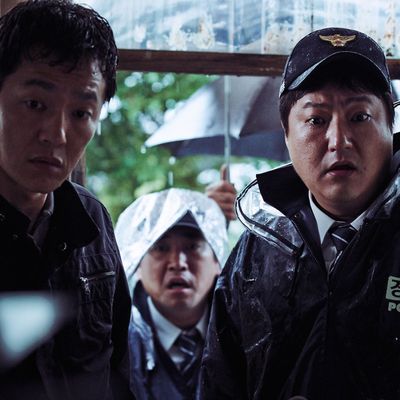
The awards have been handed out, the red carpet has been packed up, but I would be remiss not to tell you fair Vulture readers about the most bonkers movie I saw at Cannes. Not that this should come as a surprise, but the Koreans killed it with genre movies this fest; they’re operating on a level that makes most American cinema seem clunky and unimaginative. On the heels of my personal favorite, Park Chan-wook’s page-turner of a lesbian revenge saga, The Handmaiden, comes the far more naturalistic supernatural thriller The Wailing, which screened as an out-of-competition selection, from director Na Hong-jin, the maniac behind bloodbath crime flicks The Chaser and The Yellow Sea. It comes to the States on June 3, but has already set box-office records in Korea, where its opening was moved up a day because of stellar reviews. It also knocked Captain America: Civil War out of the top spot and became the eighth-biggest opening of a Korean-language movie in Korea ever.
A combination of Contagion, Keystone Cops, and The Exorcism, the story begins in the isolated rural village of Goksung (also the Korean title of the movie, which literally translates to “wailing”), where residents are turning into murderous, beast-like versions of their former selves. First, the afflicted develop rashes and boils that can’t be treated by conventional medicine. Next thing they know, they’re waking up covered in blood in their own homes, surrounded by the mutilated remains of their entire families, with no recollection of having killed them.
The bumbling local police force — led by doughy officer Jong-gu (Kwak Do-won), who shows up late to the film’s first grisly crime scene because his family insisted he eat breakfast first — suspects a bad strain of magic mushrooms, or perhaps a virus carried by the strange old Japanese man (Kill Bill’s Kunimura Jun) referred to, derogatorily, as “the Jap,” who has mysteriously arrived at the village and may or may not have come in contact with each of the victims just before they went insane. But the film’s opening quote is a passage from St. Luke in the Bible — a dead giveaway that this plague will have no earthly origins. This is about a descent into living hell.
Jong-gu the cop makes an infuriatingly human protagonist. We see him and his team botching crime scene after crime scene (“I found it!” one officer cries, holding a murder weapon above his head, before he realizes he’s not wearing gloves). And he has a wimpy tendency to run away screaming every time he’s confronted with anything frightening, which, given the increasingly horrific nature of the killings, is all the time. Back home he’s constantly emasculated by the women of his household: his wife (whom he has to have sex with in the backseat of their car because there’s no privacy in their thin-walled huts), his mother-in-law, and his sweet elementary-school-aged daughter Hyo-jin (a very impressive Kim Hwan Hee), whom he clearly adores.
But Jong-gu also seems to have been chosen to be the town’s only hope. He begins having nightmares of wrestling with a devilish creature, whom a local poacher later reports having seen running through the woods on all fours and eating a deer raw. On a subsequent crime scene, in the wreckage of a hut where a woman killed her family and then burned down her home, he’s visited by a woman in white (Chun Woo-hee) whom only he can see. But the action really picks up when he goes to confront the Jap at his foreboding shack in the mountains and comes back to discover that his own daughter Hyo-jin has caught the affliction, its cause and remedy still unknown.
We are so conditioned to accept horror as a cheap-thrills genre that it comes almost as a shock to experience the deep immersion and the rewards that accompany a dedication to realism and meticulous world-building. These are production values that in American cinema would only be seen in Oscar contenders. Between the gore may come a vista bathed in mist at sunrise, or a sweeping view of a car racing along mountain switchbacks to deliver vital information, courtesy of Snowpiercer cinematographer Hong Kyung-pyo. Shot over six months on location in real Korean villages, from a script that was two and a half years in the making, it feels like you’re actually living with these people and their fear, in their cramped wooden shacks, among the dirt and torrential rainstorms. If there’s any CGI, it’s impossible to tell. Cell phones and guns never make an appearance either; this is a battle fought with rocks, sticks, blades, and provincial mysticism. The real terror is in not knowing what lies in the dense brush of the actual forests Jong-gu and his men begin trekking through as they get closer to the truth.
There’s also plenty of humor, and zombies — did I mention the zombies? Na Hong-jin has a singular directorial voice, at once funny, frightening, and philosophical. Steeped in the guts and chase scenes are questions of faith, trust, and what it means to be a father — especially as Jong-gu is faced with decisions that may mean risking either his daughter’s life or his own. To whom can one turn when only doom seems to lie ahead? A young Catholic deacon joins the hunt, as does a flashy, pony-tailed shaman (the movie’s only matinee idol, Veteran’s Hwang Jung-min) hired by Jong-gu’s mother-in-law and bearing hexes to lure the evil spirits out of their little girl. Is he friend, a charlatan, or worse? He takes their money and goes around the village gathering every chicken he can find for sacrifice. All I’ll reveal is that in the movie’s most skillful, breathless scene (among many), we discover that good and evil look remarkably similar, both with angry, desperate rituals that carry an all-chickens-must-die sacrificial mentality. And in that flurry of flying swords and beating drums and feathers soaked in blood, the mystery only deepens. Run, chickens, run!




